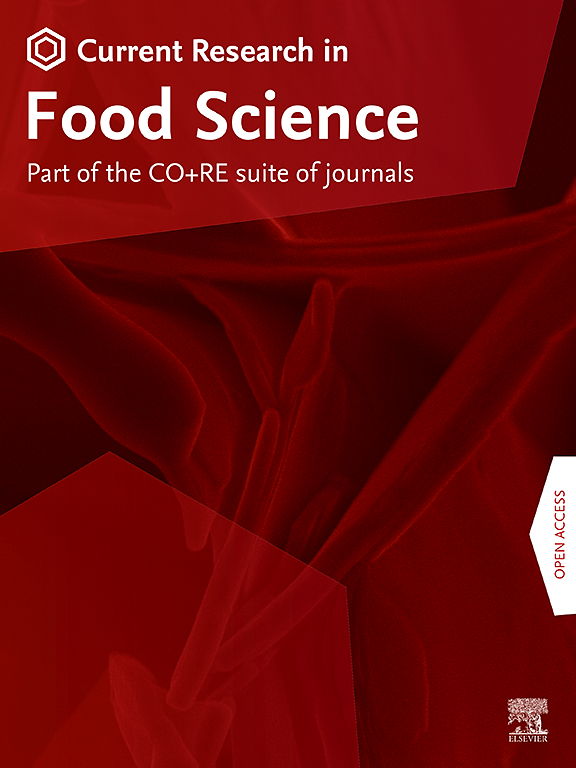Multi-omics analysis reveals the mechanism for galactose metabolism in mutant Streptococcus thermophilus IMAU20551Y
IF 6.2
2区 农林科学
Q1 FOOD SCIENCE & TECHNOLOGY
引用次数: 0
Abstract
Streptococcus thermophilus (S. thermophilus) is a species widely used in the dairy industry to accelerate the acidification rate and improve the texture and flavour characteristics of dairy products. However, most S. thermophilus have galactose-negative (Gal−) phenotypes, which can lead to accumulation of free galactose in fermented dairy products. In a previous study, a mutant of S. thermophilus IMAU20551Y was obtained by N-methyl-N′-nitro-N-nitrosoguanidine (NTG) mutagenesis in which key enzymes related to galactose metabolism were significantly changed compared with the wild type. β-galactosidase and galactokinase activity were higher in the mutant while glucokinase and pyruvate kinase activities were significantly decreased compared with the wild type. In this study, the ability of the mutant to metabolize galactose was verified by high performance liquid chromatography (HPLC), and the mechanism for enhanced galactose metabolism elucidated by multi-omics analysis. HPLC analysis showed that accumulation of galactose in milk fermented by mutant S. thermophilus IMAU20551Y was reduced by 41.4%, compared with the wild type. Although no mutations in gene sequences associated with galactose metabolism were detected by genome sequencing, transcriptomic data showed up-regulation in expression of galM, galK, galT, galE (associated with the Leloir pathway) and LacI family transcriptional regulator GalR, resulting in enhanced galactose metabolism in the mutant. This study provides a reference for genetic engineering modification of galactose-positive (Gal+) S. thermophilus, which is expected to be used as a starter for the production of low galactose fermented dairy products.

多组学分析揭示了突变型嗜热链球菌IMAU20551Y的半乳糖代谢机制
嗜热链球菌(S. thermophilus)是一种广泛应用于乳制品工业的菌种,可以加速乳制品的酸化速度,改善乳制品的质地和风味特征。然而,大多数嗜热链球菌具有半乳糖阴性(Gal -)表型,这可能导致发酵乳制品中游离半乳糖的积累。在之前的研究中,通过n -甲基-n ' -硝基-n -亚硝基胍(NTG)诱变获得了嗜热链球菌IMAU20551Y突变体,与野生型相比,该突变体中与半乳糖代谢相关的关键酶发生了显著变化。与野生型相比,突变体β-半乳糖苷酶和半乳糖激酶活性较高,葡萄糖激酶和丙酮酸激酶活性显著降低。在本研究中,通过高效液相色谱(HPLC)验证了突变体代谢半乳糖的能力,并通过多组学分析阐明了半乳糖代谢增强的机制。HPLC分析显示,突变型嗜热链球菌IMAU20551Y发酵的乳中半乳糖的积累量比野生型减少了41.4%。虽然基因组测序未检测到与半乳糖代谢相关的基因序列突变,但转录组学数据显示galM、galK、galT、galE(与Leloir通路相关)和LacI家族转录调节因子GalR的表达上调,导致突变体半乳糖代谢增强。本研究为半乳糖阳性(Gal+)嗜热葡萄球菌的基因工程改造提供了参考,有望作为低半乳糖发酵乳制品生产的发酵剂。
本文章由计算机程序翻译,如有差异,请以英文原文为准。
求助全文
约1分钟内获得全文
求助全文
来源期刊

Current Research in Food Science
Agricultural and Biological Sciences-Food Science
CiteScore
7.40
自引率
3.20%
发文量
232
审稿时长
84 days
期刊介绍:
Current Research in Food Science is an international peer-reviewed journal dedicated to advancing the breadth of knowledge in the field of food science. It serves as a platform for publishing original research articles and short communications that encompass a wide array of topics, including food chemistry, physics, microbiology, nutrition, nutraceuticals, process and package engineering, materials science, food sustainability, and food security. By covering these diverse areas, the journal aims to provide a comprehensive source of the latest scientific findings and technological advancements that are shaping the future of the food industry. The journal's scope is designed to address the multidisciplinary nature of food science, reflecting its commitment to promoting innovation and ensuring the safety and quality of the food supply.
 求助内容:
求助内容: 应助结果提醒方式:
应助结果提醒方式:


